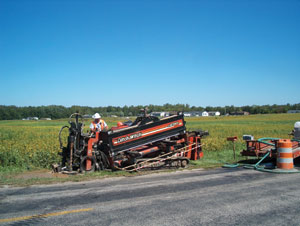Michigan Contractor Uses HDD to Keep His Business Rolling
October 1, 2008
 In the 47 years the company has beenin business, Selge Construction, Niles,Mich., has built a reputation as one ofthe most respected utility contractorsin the Southwest Michigan-South Bend,Ind. area.
In the 47 years the company has beenin business, Selge Construction, Niles,Mich., has built a reputation as one ofthe most respected utility contractorsin the Southwest Michigan-South Bend,Ind. area.Selge Construction is a multi-facetedcompany specializing in municipal sewerand water systems, low-pressure sewersystems, concrete paving and flat work.President Marv Selge Jr. grew up in thebusiness, purchasing the company fromhis father in 1992.
Selge has seen significant changes inwater and sewer construction and hasmade sure his crews are equipped withthe latest technologies to keep pacewith the needs of water and sewer utilityowners and operators.
In addition to conventional open-cutconstruction, Selge crews use bore andjacking and horizontal directional drilling(HDD) for underground infrastructureprojects.
“We are capable of handling many ofthe difficult challenges often experiencedin underground construction,” says Selge.“In conjunction with installing pipe in theground, we install a variety of lift stationsranging in size from 6 to 10 ft in diameter.We are able to take projects manycontractors are not equipped to do.”
Selge always has been alert to marketchanges and conditions. Currently SelgeConstruction is actively involved ininstalling low-pressure sewer and grinderpump systems to serve rural homes nearthe area’s many lakes. In response toinitiatives to improve water qualitystandards in rural lakes, streams andrivers, these systems are being installedto solve several problems, says Selge.
“Often,” he explains, “homes andcottages around these lakes are inproximity to each other and have old,deteriorated septic tanks buried at orbelow the groundwater table. Sewagefrom these tanks finds its way into thelakes causing contamination andincreased weed and algae growth.”
Because many lakes are outside the boundaries of townsand cities, Selge says regional sewer districts are formed tooversee the design, construction, operation and maintenanceof these low-pressure grinder pump systems.
A typical project consists of installing a small grinderstation and control panel at every residence, service linesfrom the tank to the main line, main lines to collect theinfluent from each tank, large lift stations and force mains totake the sewage to a treatment plant or tie into an existingmunicipal system if one is nearby.
“We have installed systems with as few as 68 grinder tanksand large systems with more than 500 tanks,” says Selge. “Thefirst step in a project is to install HDPE service lines — usually1.25 to 2 in. in diameter — from the proposed main linelocations to the proposed locations of the grinder stations.Once all the service lines are in the ground, a crew theninstalls the main sewer line, usually located within road rightof way. After the main lines are installed, a crew then sets thegrinder station at the predetermined location. A curb stopand a redundant check valve are usually installed on theoutside of the grinder station.”
Site Conditions Often Propose a Challenge
“With lake projects,” Selge explains, “homes often arewithin such proximity to each other, so we often deal withnarrow easements to work in, landscaping and sometimesgrinder stations on the lake side of the house where it isdifficult to reach with equipment. We have seen a widevariety of soil conditions from sand, gravel, clay and silt topeat, marl and muck, often on a single project. In additionto different soil conditions, we often deal with areas thathave high groundwater tables, especially close to lakes.”
For these and other reasons, Selge says HDD plays acritical role in the company’s low-pressure grinder systemconstruction projects.
“Directional drilling limits the amount of excavationnecessary to the tie-in points and grinder station locations,”Selge says. “HDD lets us install both service lines and mainsunder landscaping, between houses and in tight locationswhere typical open-cut operations would not be possible.HDD limits the damage to surface features, thus minimizingthe restoration needed after the pipe has been installed. Inhigh groundwater situations, HDD eliminates the need forextensive dewatering that open-cut operations wouldrequire.”
HDD equipment often used by Selge crews on these projectsincludes Ditch Witch JT2020 and JT2720 drilling units.
The compact size of the JT2020 suits it well to jobconditions found on many low-pressure sewer projects. Thelarger provides plenty of power to make longer installationsof mainline pipe. After all pipe is in place, Selge crewscomplete a low-pressure grinder system by connectingservices to the grinder stations and to the main line byfusing a branch saddle to the side wall of the main. Themain is tapped, and finally the service lines are electrofusedto the branch saddles.
Selge points out that the use of directional drillingtechnology is not new to Selge Construction — thecompany was one of the first water and sewer contractorsin the area to recognize its potential for water and sewerwork, and the benefits of HDD construction are not limitedto low-pressure sewer construction.
“We recently installed 28,000 ft of 8- and 12-in. watermain for Niles Township,” says Selge. “The job was originallybid to be open-cut, but the entire project was installed byHDD. By using this method, it minimized disruption to theheavily traveled commercial corridor and kept restorationand drive closure to a bare minimum.
“We also utilize HDD to perform river crossings formunicipal water and sewer mains, and we have used HDDin gravity-sewer operations to install sewer mains andlaterals. This causes the least amount of disturbance toheavily-traveled streets and busy highways.”
With the growing need to replace and rehabilitate thenation’s aging water and sewer infrastructure, Selge expectshis company to remain busy on a variety of projects andexpects demand for low-pressure sewer systems to continueto grow.
And as if utility construction doesn’t keep Selge busyenough, the company continues to carry out a variety oflocal paving projects and has earned many awards ofexcellence in that industry.
Jeri Briegge is public relations manager at Ditch Witch,Perry, Okla.
